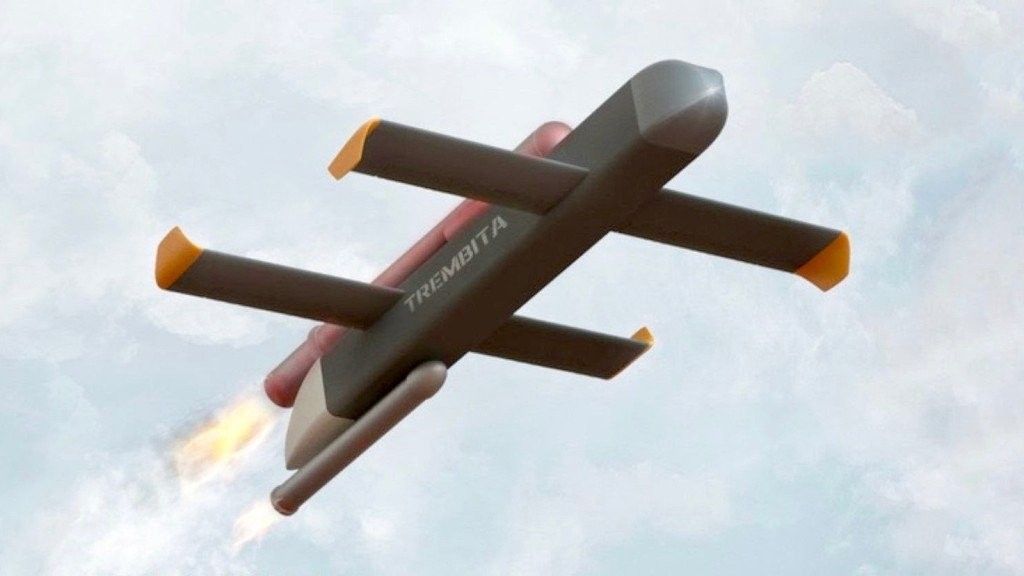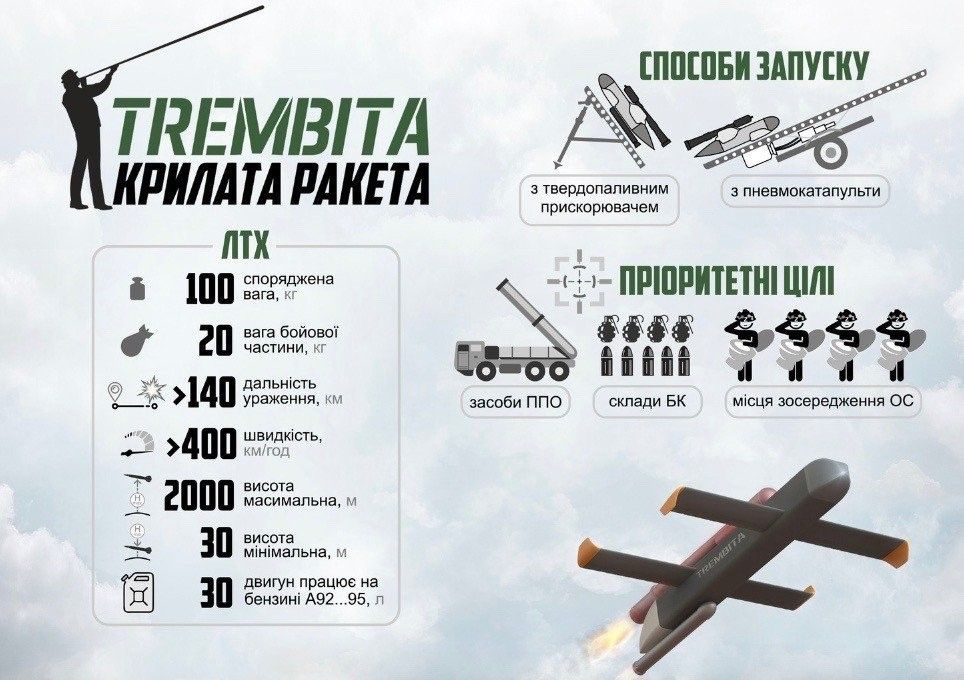
Trumpet cruise missile. The pulse engine is clearly visible on its back. Under the tail section, perhaps a rocket launcher.
Photograph. Trempita/Facebook
A Ukrainian startup is developing a cruise missile similar to the famous German V-1 flying bombs powered by a pulse jet engine. The weapon has a range of more than 140 km and should be simple and cheap to manufacture so that it can defeat Russian anti-aircraft defenses with mass deployment.
War in Ukraine – Defence24.pl special report
Work is already well advanced and the project has been given the name “Trempita”, which is derived from a folk wind instrument from the Carpathian region. This is not accidental and refers to the characteristic shape of the tool, which is somewhat similar to the shape of the machine used in this machine – a long, straight tube extended at the end. The drive unit already being tested by the Trempita team is a specific design, namely the pulse jet engine.
A cruise missile with a V-1 engine?
This is an interesting solution for this type of cruise missile or unmanned aerial vehicle. The pulse motor is simple in construction and manufacturing because it has few moving parts and above all, it is not a classic compressor. Compression of the gases is achieved thanks to the negative pressure caused by the ignition of the mixture in a sufficiently long engine pipe. The name comes from the cyclic, uniform ignition of the mixture, which causes a characteristic pulsating sound and significant vibrations, which is one of the main disadvantages of this drive. The second is low thrust during take-off, because the thrust in a pulse engine depends on the amount of air sucked in, i.e. the speed of the aircraft. Hence, it is necessary to use launchers or launch engines. The advantages of this design are ease of manufacture, low material requirements, and the ability to run the engine with normal E92 or E95 gasoline.
The features of this machine can be clearly seen in the test video as volunteers from the PARS team ignite it using a simple garden hose. After reaching the correct pressure and temperature, the machine works independently and the specific pulse can be heard perfectly. The most famous design with such a drive was the German V-1 flying bomb (Fiesler Fi-103), the first “Wunderwaffe”, which brought England to its knees. Hence the slightly perverse title for this text.
A dual-use weapon
However, while the V-1 was a terrorist weapon, the concept of using the Trempita, similar to the Iranian kamikaze drones currently used by the Russians, was entirely different. Missiles or jet drones, as it is difficult to accurately classify them in this construction matter, must fulfill two tasks.
The first, of course, is to attack targets in the depth of Russian groups, thanks to a planned range of 140 km and a 20 kg high-explosive or thermobaric warhead. Reaching a speed of about 400 km / h and operating at a ceiling of 30 to 2000 meters, Trumpets are very effective, especially when fired in swarms of more than 20 machines, which is the assumption of the system. A greater number of cheap shells means a greater chance of a successful attack.
The first leads to the second use, namely as a decoy role and a cheap, widely used drone-target for enemy air defense. Here, the advantage of the system is again the engine – simple, cheap, but generates a significant amount of heat. Thanks to this, it is a more attractive target for anti-aircraft missiles, especially MANPADS, than other flying machines. As the creators emphasize – “Our simple rocket is incomparably cheaper than the missiles of enemy anti-aircraft systems.” They also mention the psychological effect of the very loud and distinctive Trempit missile engine, which can be very demoralizing to Russian soldiers, especially if the weapon is effective and recognizable.

Basic data about Trumpet Missile.
Photograph. Trempita/Facebook
Will Trempida breach Russian air defenses?
Such multiple targets can effectively disrupt and overburden enemy air defenses. In a sense, this is an idea for Ukraine’s response to Russia’s massive drone and cruise missile attacks, but directed against enemy troops, not its civilians. Inexpensive, mass-produced missiles that may or may not carry a combat load are a threat that an adversary cannot ignore. This not only consumes ammunition and fatigue, but also puts additional stress on the enemy’s logistics.
Another advantage noted by the creators of the Trumpet is the possibility of manufacturing its components in dispersion, by non-specialized plants or workshops. As the creators insist, the Russians cannot destroy such scattered production, and it could have a significant impact on combat operations. Therefore, PARS team volunteers are currently looking for volunteers to participate in the design, financing and production of the Trembita system. The chances of success and potential applications of the “Ukrainian V-1 missile” seem very high.

. “Hardcore internet junkie. Award-winning bacon ninja. Social media trailblazer. Subtly charming pop culture advocate. Falls down a lot.”
